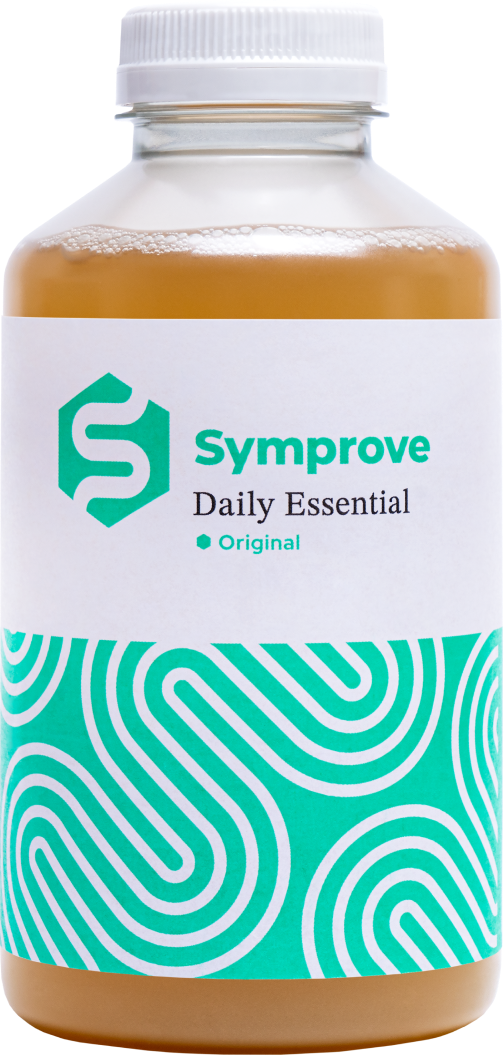What is the infant gut microbiome?
The gut microbiome refers to the genetic material of a community of microorganisms in a specific environment.(1) The development of an infant’s microbiome is a process that likely begins prior to birth, with gut microbial composition influenced by maternal genetics and diet. From birth and beyond, it is affected by a variety of early life exposures including prenatal environment, mode of delivery, antibiotic usage and diet.(2)
Maternal influences during pregnancy
The mother’s own microbiota influences the initial colonisation of the infant’s microbiome in utero. Therefore, maternal diet has a direct influence on the infant’s developing microbiome.(2)
Gestational weight status
Body mass index (BMI) and weight gain are important markers of nutritional status in pregnant women.(3) Raised pre-pregnancy BMI and excessive weight gain during gestation are associated with changes in maternal microbial composition (dysbiosis). This can have negative consequences for establishing the infant’s microbiome.(3)
A study which examined gut microbiota, BMI and gestational weight gain in pregnant women found reduced populations of Bifidobacteria and Bacteroides in overweight women, compared with women of optimal pre-pregnancy BMI. Acceptable weight gain during pregnancy, as advised by the World Health Organisation (WHO), has been related to high numbers of maternal Bifidobacteria, which is transferred to the infant.(4) It is suggested that an abundance of Bifidobacteria during infancy is protective against childhood obesity.(3)
Maternal dietary intake
Perinatal maternal dietary intake has been associated with changes in the infant’s microbiome. A prospective cohort study found that infants exposed to a maternal high-fat diet during gestation had a depletion of Bacteroides (which promotes healthy gut mucosal immunity) until six-weeks of age.(5)
A further study categorised the maternal microbiome according to dietary intake of carbohydrate, fibre, proteins and fats.6 High-carbohydrate gestational diets were associated with an abundance of Prevotella (which plays a role in glycogen storage) in the maternal and infant microbiomes. A high-fibre and omega-3-rich diet was associated with dominance of Ruminococcus, which produces the beneficial short-chain fatty acid (SCFA) butyrate.(6,7) Current dietary recommendations for pregnancy encourage a fibre-rich diet containing plenty of fruits and vegetables, lean protein and healthy fats (including omega-3s).(8)
Birthing method
Birthing method influences the diversity of gut microbiota during the first three months of age and has been associated with health outcomes in later life.9 Vaginally delivered infants have an abundance of Bifidobacteria and Bacteroides, compared with dominance of Clostridium and Lactobacillus in infants delivered by CS.9 An abundance of Bifidobacteria supports immunity development, whereas high numbers of Clostridium can increase the risk of severe gastrointestinal infections during infancy.(9)
CS delivery is linked with childhood asthma and obesity, although the association has not been found beyond the age of five.(10) A recent observational study reported that infants of overweight mothers delivered by CS had a 5-fold risk of being overweight at one-year-old with a similar risk at three-years-old.(11) However, further research is required.
The first 1,000 days of life
The first 1,000 days refers to the period from conception to two-years-old. It represents the phase of childhood growth and development. The assembly of the infant’s gut microbiome is fundamental in the maturation of developmental pathways.(12) Disruption of microbial colonisation during this critical window may contribute to diseases in childhood and adulthood.(13)
Breast milk and infant formula
Breast milk is a source of natural probiotics; it contains diverse microbes which are influenced by factors such as maternal gestational weight, birthing method and geographical location. After the initial exposure to maternal vaginal and skin microbiota during birth, human milk oligosaccharides (HMOs) found in breast milk have a prebiotic effect which further diversifies the infant microbiome.(14)
HMOs are highly abundant in human breast milk (10-20g/L).(15) Bifidobacterium, (the dominant microbial strain in breastfed infants), utilises HMOs to produce beneficial SCFAs, which help to regulate the immune system.(14,16) Infant formulas which contain HMOs have been developed to help formula-fed infants establish a Bifidobacterium rich microbiota.(16)
Weaning
The WHO recommends that complementary feeding (weaning) should begin between four- to six-months-old. It is important that weaning progresses during this window in order to optimise growth and the development of the digestive system.(17)
The introduction of solid food causes a change in the gut microbiome. The infant’s microbial composition transitions from an abundance of Bifidobacteria to Bacteroidetes and Firmicutes dominant communities.(16,18)
The gut microbiomes of children (three- to ten-years-old), compared with those of infants are much less dynamic. Geographical location and cultural dietary differences are prime factors that alter the microbiota in childhood. Children living in economically developed countries have been found to have poor microbial diversity and a dominance of microbes which are associated with high animal protein and high-fat diets (i.e. Bacteroides and Firmicutes).(16)
Children living in less economically developed countries have been found to have higher microbial diversity and a dominance of microbes associated with carbohydrate-rich diets (i.e. Prevotella). These differences in microbial composition may coincide with increased incidence of autoimmune diseases such as Inflammatory Bowel Disease (IBD) in developed countries,(16) however further research is required.
Summary
– The infant’s gut microbiome is first colonised by maternal microbiota.
– Raised pre-pregnancy BMI may cause dysbiosis of maternal microbiota, which can influence the infant’s gut microbiome.
– The birth environment plays a critical role in establishing gut microbiota in early life and can affect long-term childhood outcomes.
– After the transition to solid food, a child’s microbiome composition resembles that of an adult and reaches a point of stability.
Footnotes -
[1] Cresci GAM, Lampe JW, Gibson G. Targeted Approaches for In Situ Gut Microbiome Manipulation Journal of Parenteral and Enteral Nutrition. 2020;
[2] Lundgren SN, Madan JC, Emond JA, Morrison HG, Christensen BC, Karagas MR, et al. Maternal diet during pregnancy is related with the infant stool microbiome in a delivery mode-dependent manner. Microbiome. 2018;6(1):109. Available from: https://microbiomejournal.biomedcentral.com/articles/10.1186/s40168-018-0490-8
[3] García-Mantrana I, Bertua B, Martínez-Costa C, Collado MC. Perinatal nutrition: How to take care of the gut microbiota? Clinical Nutrition Experimental. 2016;6:3–16.
[4] Santacruz A, Collado MC, García-Valdés L, Segura MT, Marítn-Lagos JA, Anjos T, et al. Gut microbiota composition is associated with body weight, weight gain and biochemical parameters in pregnant women. British Journal of Nutrition. 2010;104(1):83–92. Available from: https://pubmed.ncbi.nlm.nih.gov/20205964/
[5] Chu DM, Antony KM, Ma J, Prince AL, Showalter L, Moller M, et al. The early infant gut microbiome varies in association with a maternal high-fat diet. Genome Medicine. 2016;8(1):77. Available from: https://genomemedicine.biomedcentral.com/articles/10.1186/s13073-016-0330-z
[6] Microbiome and Metabolome in Diagnosis, Therapy, and other Strategic Applications. Available from: https://www.sciencedirect.com/book/9780128152492/microbiome-and-metabolome-in-diagnosis-therapy-and
[7] García-Mantrana I, Selma-Royo M, González S, Parra-Llorca A, Martínez-Costa C, Collado MC. Distinct maternal microbiota clusters are associated with diet during pregnancy: impact on neonatal microbiota and infant growth during the first 18 months of life. Gut Microbes. 2020;11(4):962–78. Available from: https://www.tandfonline.com/doi/full/10.1080/19490976.2020.1730294
[8] The British Dietetic Association. Pregnancy and diet. Available from: https://www.bda.uk.com/resource/pregnancy-diet.html
[9] Rutayisire E, Huang K, Liu Y, Tao F. The mode of delivery affects the diversity and colonization pattern of the gut microbiota during the first year of infants’ life: A systematic review. BMC Gastroenterology. 2016;16(1). Available from: https://pubmed.ncbi.nlm.nih.gov/27475754/
[10] Keag OE, Norman JE, Stock SJ. Long-term risks and benefits associated with cesarean delivery for mother, baby, and subsequent pregnancies: Systematic review and meta-analysis. PLoS Medicine. 2018;15(1):e1002494. Available from: https://doi.org/10.1371/journal.pmed.1002494
[11] Tun HM, Bridgman SL, Chari R, Field CJ, Guttman DS, Becker AB, et al. Roles of birth mode and infant gut microbiota in intergenerational transmission of overweight and obesity from mother to offspring. JAMA Pediatrics. 2018;172(4):368–77. Available from: https://jamanetwork.com/journals/jamapediatrics/fullarticle/2672735.
[12] Robertson RC, Manges AR, Finlay BB, Prendergast AJ. The Human Microbiome and Child Growth – First 1000 Days and Beyond. Vol. 27, Trends in Microbiology. 2019. p. 131–47.
[13] Tamburini S, Shen N, Wu HC, Clemente JC. The microbiome in early life: Implications for health outcomes. Vol. 22, Nature Medicine. Nature Publishing Group; 2016 p. 713–22. Available from: https://www.nature.com/articles/nm.4142
[14] Moossavi S, Miliku K, Sepehri S, Khafipour E, Azad MB. The prebiotic and probiotic properties of human milk: Implications for infant immune development and pediatric asthma. Vol. 6, Frontiers in Pediatrics. Frontiers Media S.A.; 2018. Available from: https://www.ncbi.nlm.nih.gov/pmc/articles/PMC6095009/
[15] Smilowitz JT, Lebrilla CB, Mills DA, German JB, Freeman SL. Breast Milk Oligosaccharides: Structure-Function Relationships in the Neonate. Annual Review of Nutrition. 2014;34(1):143–69. Available from: https://www.ncbi.nlm.nih.gov/pmc/articles/PMC4348064/?report=abstract
[16] Tanaka M, Nakayama J. Development of the gut microbiota in infancy and its impact on health in later life. Vol. 66, Allergology International. Japanese Society of Allergology; 2017. p. 515–22.
[17] Complementary feeding – Global. Available from: https://www.who.int/health-topics/complementary-feeding#tab=tab_1
[18] Rinninella E, Raoul P, Cintoni M, Franceschi F, Miggiano GAD, Gasbarrini A, et al. What is the healthy gut microbiota composition? A changing ecosystem across age, environment, diet, and diseases. Microorganisms. 2019;7(1):14. Available from: https://www.ncbi.nlm.nih.gov/pmc/articles/PMC6351938/?report=abstract



